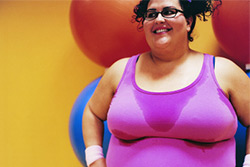Exercising when overweight: moderation is key

The battle of the bulge rages on in the United States, with more people than ever falling victim to it. According to the National Institutes of Health, more than 35 percent of U.S. adults are obese, and more than 34 percent are overweight. Aside from dieting, the only other proven way of getting in shape is through adding regular exercise.
“Overweight people have a higher risk of many health complications, including heart disease, diabetes, and hypertension, and that’s why dropping that excess weight by eating less and moving more is so important,” says Dr. Heng Chao Terry Wei, a ColumbiaDoctors internist. “But for people carrying excess weight, there are certain precautions they should take before embarking on an exercise regime — particularly when the weather is hot.”
Before you begin any exercise regime, visit your health care provider to assess if you are healthy enough to start a regular fitness routine and which exercises are best for you. “Obese individuals weigh more, and therefore should avoid moves that put stress on their ankles, hips, knees, and lower back if they wish to avoid injuries,” says Dr. Wei.
The American College of Sports Medicine recommends that overweight individuals gradually build to a workout of up to 250 minutes of weekly moderate-intensity exercise to increase weight loss. This can take any form, for instance, five 50-minute workouts per week or seven 37-minute workouts a week.
Weight-friendly workouts
Walking
Walking is the ideal low-impact exercise. The only requirement is comfortable shoes, preferably sneakers and can be done almost everywhere, and improves lower body strength and mobility. “However, walking isn't for everyone,” warns Dr. Wei, “If you experience knee, back, or hip pain, talk to your healthcare provider. You may be able to work with a physical therapist or exercise professional to address the issue or come up with a better routine for fitness.” Consistency is key when starting a walking program. Set weekly goals, vary your routine and gradually add distance, intensity and speed to make the workout more effective.
Swimming
Swimming is perhaps the best cardio, pulmonary and skeletal exercise a person can do. It offers a total body workout that’s easy on the joints, and it increases core strength and balance while burning fat and calories. Says Dr. Wei, “For people with weight problems, swimming offers the added benefit of staying cool in the water, so they are able to workout longer than they could in other environments.” In addition to swimming, specialized water-based exercises, such as water-jogging and water-aerobics are excellent ways to burn calories for weight loss.
Cycling
Biking is an efficient form of burning calories while putting less stress on your joints. A recumbent bike is good for people who have back pain, joint problems, or simply need more support. There are also recumbent cross trainers on the market, which offer more variety if you get bored pedaling. The machine is similar to a stepper and works both the upper and lower body with less stress on the joints. Then there’s the portable peddler, small, lightweight devices that let you pedal while seated at your desk or in a comfortable chair. “With this and with all exercises, the key is to start slowly and make consistency your goal,” advises Dr. Wei. “Try to pedal for five minutes, then rest. Pedal again for five minutes, then rest again. Gradually increase the duration of your pedaling interval and decrease the rest interval. Get off the bike as needed to stretch your joints and relax out of the saddle.”
Strength Training
The best way to burn fat is to build muscle at the same time, and that requires strength exercises such as lifting light weights, and resistance exercises such as chest and leg presses, leg curls and lateral pulldowns. Once the original exercises start feeling too easy, start increasing the number of reps or the weight you lift. “Another benefit to strength training is that it can correct postural issues that may arise from carrying extra weight,” says Dr. Wei. “It can also increase the range of motion in the joints. Finally, when you build muscle, you boost your metabolism when your body is at rest, which means more calories are being burned for longer periods.”
Exercise is a powerful tool, one that can help you lose weight, improve body function, and boost mood and confidence. But Dr. Wei adds a cautionary note about exercising in summertime: “Be sure to take certain precautions — drink six to eight glasses of water a day for proper hydration, limit your sun exposure, and apply sunscreen.”
For articles on health and wellness, visit our health library. To find a primary care doctor or weight management specialist, please call 877-697-9355.



